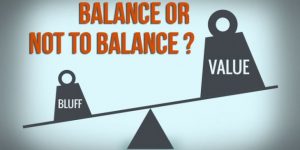
Discussed at the idea of centrality in poker, we have gone beyond Holistic poker theories threshold. This area is known for its widely discussed key ideas: balance, exploitation, game theory and so on. But in order to really understand and use this knowledge, we need to understand its foundations. One of the key concepts that often boggles the minds of players is equilibrium, or balance, so that is where we will start.
So what is balance?
We can start by saying that this is basically an idea that says you have to balance betting, bluffing and value hands. It's a good start, but it's much more subtle than that.
The truth is that balance is a vague concept that people usually use to fill in the gaps in your thinking about poker. If you ask someone "Why did you just pacheck the set back?" or "Why are you betting with middle pair?" or "Why are you bluffing on the river?" the most common answer from embarrassed mid-level players is that they are doing it to keep their balance. But if you asked them to give a definition, they wouldn't be able to give a definitive answer. The word is thrown around quite liberally.
Balance can be divided into two main ideas, depending on what the word is used for. The first idea is that for a range to be balanced, it must contain both value hands and bluffs. The second is that for a range to be balanced, it must contain both the strongest and the medium strongest hands. If you have too much of one and not enough of the other, you are out of balance here.
Let's take a closer look at this definition. What does it mean, more precisely, that an interval must have both value hands and bluffs? How many must there be? Is one bluff per 100 hands enough? So here we come to the point where it turns out that the idea of balance is closely related to another concept, the "unexploitable" game, which comes from game theory and simply means that the strategy we use cannot be played by others. It can never lose to any other strategy. For example, if we play a game of rock-paper-scissors, the unexploitable strategy (also called the GTO-game theory optimal) is to randomly make each move 33% of game time. With this strategy, no matter how the opponent plays, he will be the loser after averaging.
Most poker players end their careers by balancing with unexploitable play. They think that in order to have balance, their playing range has to be unbreakable, "perfectly balanced". This would mean that you have to create an interval in which, when you make a pot-sized bet on the river with no draw, you bluff 33% and 66% for value bets.
The balance sheet presented in this way looks very attractive and you might think it would solve all problems. But there are two misconceptions that players often face when thinking about balance. The first is to assume that you are either completely balanced or completely out of balance. The second is that balance is intrinsically valuable when in reality it is not.





